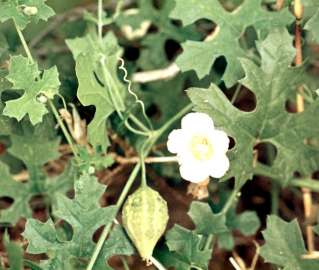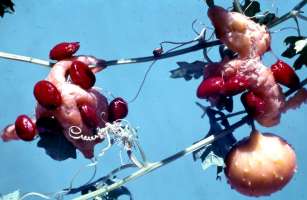Momordica balsamica
Momordica balsamina L.
Family: Cucurbitaceae
Common names: balsam pear (Eng.); laloentjie (Afr.); mohodu (Sotho); nkaka (Thonga); intshungu, intshungwana yehlathi (Zulu)
Introduction
This climber with bright green leaves bears striking orange to red spindle shaped ripe fruit.

Description
Description
Glabrous to slightly hairy perennial herb with a tuberous rootstock, whole plant bad-smelling (rather like the common thorn apple or Datura stramonium ), more so when bruised. Stems mostly annual, prostrate or climbing, to 5 m long, cut twigs exude clear sap. Tendrils simple. Leaves waxy, lower surface paler than upper, deeply palmately 5-7-lobed, to 12 cm long, margin toothed, stalked.
Flowers solitary, male and female flowers on the same plant (monoecious). Male flowers prominently bracteate (subtended by a leaflet), bract ± ovate, to 18 mm long, pallid, green-veined, calyx green to purplish-black, corolla white to yellow, apricot or orange, green-veined, with grey, brownish or black spots near the bases of the three inner petals, 10-20 mm long, anthers orange. Female flowers inconspicuously bracteate, corolla rather smaller than males.
Fruit spindle shaped, dark green with 9 or 10 regular or irregular rows of cream or yellowish short blunt spines, ripening to bright orange or red, 25-60 mm long, opening automatically more or less irregularly into three valves that curl back (also opens when the tip is touched). Seeds ovate in outline, rather compressed, up to 11 mm long, light brown, surface sculptured; encased in a sticky scarlet red fleshy covering that is edible and sweet, tasting like watermelon.

The balsam pear flowers and fruits throughout the year, but mainly from October to May.
Distribution and habitat
Distribution description
M. balsamina is fairly common and widespread in Namibia, Botswana, Swaziland and all the provinces of South Africa except the Western Cape. It is also indigenous to tropical Africa and Asia, Arabia, India and Australia. It has been cultivated in gardens in Europe since the 1800's.
The balsam pear grows in white, yellow, red and grey sandy soil, also loam, clay, alluvial, gravelly and calcareous soil. It thrives in full sun and semi-shade in grassland, savanna, woodland, forest margins, coastal dune forests and in river bank vegetation as well as disturbed areas.
In southern Africa it grows from about sea level to 1465 m altitude, in dry to wet areas with a rainfall of 200-1200 mm annually. It seems to be frost hardy.
Derivation of name and historical aspects
History
The genus name Momordica could perhaps refer to the sculptured seeds or the uneven appearance of the fruits, which look as if they had been bitten; the Latin mordeo means to bite. However, Jackson (1990) doubts this explanation. The specific epithet balsamina means 'like balsam/balm', from the Latin balsamum, and refers to one of the medicinal uses of this plant.
More about the Cucurbitaceae family can be found on the Lagenaria sphaerica page.
Momordica is an Old World genus of about 40 species, the majority of them in tropical Africa. They are recognized by the seeds that are always enveloped in bright red pulp and by the often prominent bracts subtending the male flowers.
Ecology
Ecology
The fruit is eaten by birds, ants, probably by some mammals (though not recorded) and also by humans.
Uses
Use
The leaves and green fruit are cooked and eaten as spinach, sometimes with groundnuts, or simply mixed with porridge. The young leaves contain vitamin C. The raw ripe fruits are also eaten.
According to Watt and Breyer-Brandwijk (1962), the plant contains a bitter principle momordicin. They report that 'overseas a liniment, made by infusing the fruit (minus the seed) in olive or almond oil, is used as an application to chapped hands, burns and haemorrhoids and the mashed fruit is used as a poultice'. This practice probably explains the species name balsamina. Watt and Breyer-Brandwijk also list many medicinal and other uses of M. balsamina in tropical Africa and elsewhere.
Hutchings et al. (1996) report that the Zulu use infusions of this plant for stomach and intestinal complaints. It is also used in a poultice for burns and is reputed to be used to treat diabetes. The Vhavenda take leaf infusions as anti-emetics. There are conflicting reports on the toxicity of the fruit, both green and ripe. The green fruit contains a resin, toxic alkaloids and a saponic glycoside that cause vomiting and diarrhoea; these substances are denatured in the cooking process. The fruit is suspected of poisoning dogs and pigs.
Roodt (1998) states that the medicinal action of the fruit results from the saponic glycosides present. She reports uses in the Okavango delta and elsewhere for abortion, boils, burns, chapped hands and feet, external sores, frostbite, haemorrhoids, headache, and as a purgative.
The leaf sap is said to be an effective metal cleaner. In the past, the green fruit had been used as an ingredient of arrow poison. In the Okavango delta, the fruit can be used in cursing one's enemy; his/her stomach will burst in the same way that the ripe fruit bursts open spontaneously!
Growing Momordica balsamica
Grow
This species is not discussed in any of the standard horticultural books on indigenous South African plants. However, its natural habitat and ecology can be used as guidelines. The balsam pear can be grown from seed in most areas, as long as the young plants are protected against drought, severe frost and too much sunlight. As a climber, the stems will need some support to give a showy effect.
References
- Hutchings, A., Scott, A.H., Lewis, G. & Cunningham, A.B. 1996. Zulu medicinal plants, an inventory. University of Natal Press, Pietermaritzburg.
- Jackson, W.P.U. 1990. Origins and meanings of names of South African plant genera. Ecolab, Botany Dept., University of Cape Town.
- Jeffrey, C. 1967. Flora of Tropical East Africa. Cucurbitaceae: 17-40.
- Jeffrey, C. 1978. Cucurbitaceae. Flora zambesiaca 4: 419-429.
- Meeuse, A.D.J. 1962. The Cucurbitaceae of southern Africa. Bothalia 8: 45-52.
- Pooly, E. 1998. A field guide to wild flowers, KwaZulu - Natal and the eastern region. Natal Flora Publications Trust.
- Roodt, V. 1998. The Shell field guide series : part II. Common Wild Flowers of the Okavango Delta, medicinal uses and nutritional value. Russel Friedman Books, Halfway House, South Africa.
- Van Wyk, B.-E., Gericke, N. 2000. People's plants, a guide to useful plants of southern Africa. Briza, Pretoria.
- Watt, J.M. & Breyer-Brandwijk, M.G. 1962. Medicinal and poisonous plants of southern and eastern Africa, edn 2. Livingstone, Edinburgh & London.
Credits
Mienkie Welman
National Herbarium, Pretoria
December 2004
Plant Attributes:
Plant Type: Climber
SA Distribution: Eastern Cape, Free State, Gauteng, KwaZulu-Natal, Limpopo, Mpumalanga, North West, Northern Cape
Soil type: Sandy, Clay, Loam
Flowering season: Early Summer, Sporadic/All year
PH: Neutral
Flower colour: White, Cream, Orange
Aspect: Full Sun
Gardening skill: Easy
Special Features:
Horticultural zones










Rate this article
Article well written and informative
Rate this plant
Is this an interesting plant?
Login to add your Comment
Back to topNot registered yet? Click here to register.